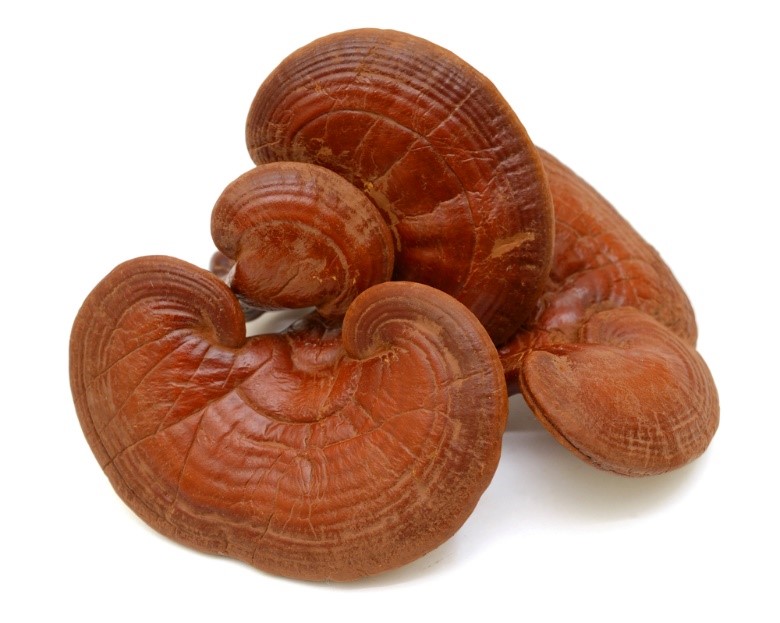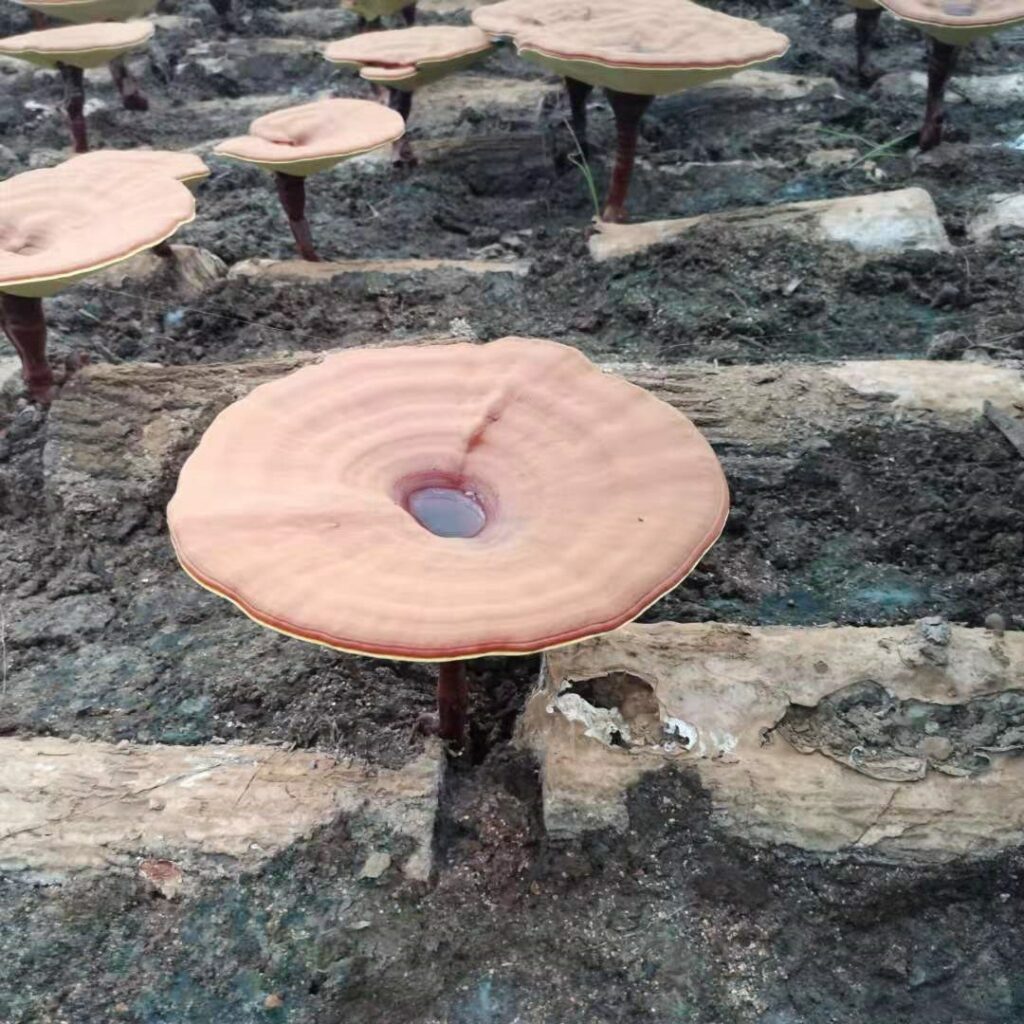Places of Origin:
Lingzhi is primarily produced in the East and Southwest China, as well as the provinces of Guangxi, Jilin, and Hebei, etc. Natural Lingzhi is mainly grown in the Yangtze River and Yellow River basins.

Places of Origin:
Lingzhi is primarily produced in the East and Southwest China, as well as the provinces of Guangxi, Jilin, and Hebei, etc. Natural Lingzhi is mainly grown in the Yangtze River and Yellow River basins.
Lingzhi is a kind of high temperature fungus. The optimum temperature for its growing is 25℃~30℃ with an air humidity of 85%-95%. If the relative air humidity (RH) is too low, the Lingzhi produced will be of poorer quality. Lingzhi is an aerobic fungus, and fresh air is essential in its entire growth period. If the concentration of the carbon dioxide in the air is greater than 0.1% by volume of the atmosphere, the sporocarp will not evolve. Light also plays an important role in the growth of Lingzhi. It grows much faster in the dark without any light.
Lingzhi can be divided into log Lingzhi, basswood Lingzhi, and bagged material Lingzhi, etc., according to its cultivation pattern.
Lingzhi grown with tree trunks as raw material is called log Lingzhi. Its sporocarp is fat, its cap is thick, and its spore powder has the highest oil content among all types of Lingzhi. Log Lingzhi is a precious variety of Lingzhi.
The basswood Lingzhi, which was cultivated on big basswood, has the highest content of polysaccharide and richer monosaccharide composition.
The bagged material Lingzhi is mainly cultivated with sawdust as the culture medium. The yield of bagged material Lingzhi is high, and the duration of growth cycle of bagged material Lingzhi is shorter. Though cultivated with sawdust, bagged material Lingzhi can still retain its polysaccharides, amino acids and other nutrients.
Lingzhi is umbrella-like shaped, and its cap is kidney-shaped. The shape of “Ruyi”, a curved decorative object which represents auspiciousness in ancient times, was derived from the shape of Lingzhi. The cap of Lingzhi is the medicinal part that can be processed into tablets for easy volatilization of the medicinal effect when ingested. Lingzhi is a representative species in the genus Ganoderma. Its surface is yellowish brown to reddish brown, and lustrous.

Figure 1: Lingzhi on basswood

Figure 2: Lingzhi after processing
Lingzhi has a long medicinal history in China. As early as in the ancient book, “Liezi·Tangwen”, about 2400 years ago in China, there was already a record of Lingzhi as “On the rotten soil, there are mushrooms”. The earliest medicinal book of China, “The Divine Farmer’s Herb-Root Classic”, regarded Lingzhi as a top grade Ganoderma[1] 尚志鈞 校注. 神農本草經校注[M]. 北京: 學苑出版社,2008: 28., and recorded that “It clears the phlegm in the chest, strengthens the heart, supplements qi, increases wisdom and enhances memory. After long-term ingestion of it, one’s body will be kept young, and life will be prolonged. It is Dan Lingzhi, and it grows in the valley.”
By the Ming dynasty, a great masterpiece, the “Compendium of Materia Medica”, in the history of Chinese medicine recorded the color and species of Lingzhi, and described the characteristics and functions of Lingzhi in detail. According to ancient records, the genus Ganoderma that people were familiar with was often referred to as Lingzhi, and its form and medicinal efficacy are consistent with contemporary understanding of it [2] 趙繼鼎. 我國古籍中記載六芝的初步考證[J]. 微生物學通報, 1989, 16(3): 36-43..
It is recorded in “The Divine Farmer’s Classic of Materia Medica, Shen Nong Bencao Jing” that Lingzhi can strengthen the body resistance and the constitution, nourish and strengthen the body, and prolong life. Modern pharmacology shows that Lingzhi not only improves the body’s immunity, but also regulates blood sugar, acts as adjuvant therapy in the treatment of tumors, protects the liver, relieves cough, maintains beauty and keeps young[3] YANG Y, ZHANG H, ZUO J, et al. Advances in research on the active constituents and physiological effects of Ganoderma lucidum [J].Biomedical Dermatology,2019,3(1):6.. The main active ingredients listed below are the components that make Lingzhi contain such rich medicinal value.
1. Polysaccharides
Polysaccharides in Lingzhi are the key components to enable its immunomodulatory, anti-tumor and anti-radiation effects[3] YANG Y, ZHANG H, ZUO J, et al. Advances in research on the active constituents and physiological effects of Ganoderma lucidum [J].Biomedical Dermatology,2019,3(1):6.. The polysaccharides can significantly improve the immune function of the body and protect the liver by stimulating the immune system [4] Zhang Yiwen, Feng Yanbo, Wang Wenshuai et al. Ganoderma lucidum Characterization and Hepatoprotections of Polysaccharides against Multiple Organ Dysfunction Syndrome in Mice.[J] .Oxid Med Cell Longev, 2021, 2021: 9703682., and have a good adjuvant treatment effect on common modern sub-health conditions. The polysaccharides can also delay aging by resisting free radicals, and inhibiting the oxidation process of the human body[5] Shen Shuhua, Wang Xiaoming, Lv Hang et al. PADI4 mediates autophagy and participates in the role of ganoderic acid A monomers in delaying the senescence of Alzheimer's cells through the Akt/mTOR pathway.[J] Biosci Biotechnol Biochem, 2021..
2. Ganoderic acids
Ganoderic acids are important active components in the triterpenoids of Lingzhi [6] Abulizi Abudumijiti, Hu Ling, Ma Ang et al. Ganoderic acid alleviates chemotherapy-induced fatigue in mice bearing colon tumor.[J] .Acta Pharmacol Sin, 2021, undefined: undefined.. The more bitter the Lingzhi, the higher is the content of the ganoderic acid. Ganoderic acids are the components that makes Lingzhi have the effects of relieving cough, expectorant, relieving spasm, and asthma remission[7] RAHMAN MA , ABDULLAH N , AMINUDIN N. Evaluation of the antioxidative and hypo-cholesterolemic effects of lingzhi or reishi medicinal mushroom, Ganoderma lucidum (agaricomycetes), in ameliorating cardiovascular disease [J].Int J Med Mushrooms, 2018,20 (10) : 961 - 969.. Besides, ganoderic acids have the functions of liver protection, pain relief, and detoxification.
3. Sterols
Lingzhi contains high component of sterols, such as ergosterol, ergosterol palmitate, etc. Sterols can significantly improve the immune function of the human body, and prevent the growth of tumor cells. It is one of the reasons why Lingzhi is used to treat cancer [8] Xu Juan, Xiao CongMei, Xu HaiShun et al. Anti-inflammatory effects of Ganoderma lucidum sterols via attenuation of the p38 MAPK and NF-κB pathways in LPS-induced RAW 264.7 macrophages.[J] .Food Chem Toxicol, 2021, 150: 112073..
4. Amino Acids and Trace Elements
In addition, Lingzhi also contains amino acids and microelements necessary for the human body, which can improve human immunity, reduce inflammation, and promote skin conditions. This makes Lingzhi a good choice for both maintaining beauty and health simultaneously[9] Lian Lingdan, Wang Lingshuai, Song Shuqi et al. Ganoderma lucidum GCN4 regulates secondary metabolism through activating antioxidant genes expression under nitrogen limitation in .[J] .Appl Environ Microbiol, 2021, undefined: undefined..
As a medicinal and edible fungus, there were records in the ancient herbal books that the processing method of Lingzhi was dried in the shade. It was recorded in the 2020 edition of Chinese Pharmacopoeia [10] 國家藥典委員會.中國藥典[M].北京:中國醫藥科技出版社,2020:1088. that Lingzhi is “harvested throughout the year by removing impurities, cutting off the lower stipe with rotten wood, silt or substrate attached, and drying in the shade or drying at 40-50°C”.
Lingzhi is a mild nature precious herb with extremely high nutritional value. Currently, no contraindication was reported for the edible collocation on Lingzhi. Lingzhi can be taken with almost all kinds of food ingredients and medicines, and it has been included in the catalog of “Medicine and Food Homology” in China.
In Overseas, the medicinal value of Lingzhi has been recognized in many ways. It has currently been included in the “American Herbal Pharmacopoeia and Therapeutic Compendium”, and its quality and safety have been affirmed. In countries such as Japan and South Korea, Lingzhi is being used as a functional food in medicinal diets, biscuits and beverages. The wide application of Lingzhi in daily life has confirmed its safety[11] Wicks SM, Tong R, Wang CZ et al. Safety and tolerability of Ganoderma lucidum in healthy subjects: a double-blind randomized placebo-controlled trial. Am J Chin Med. 2007;35(3):407-14.. So far, there was no report on the acute toxicity, long-term toxicity, genetic toxicity, and adverse reactions of Lingzhi, thus shows that Lingzhi has good safety.
Clinical studies of Lingzhi focus predominantly on anti-tumor and improving immunity. So far, 23 clinical studies, involving 4246 patients, have proved that the combined use of Lingzhi can prolong the overall survival time of cancer patients undergoing radiotherapy and chemotherapy, increase the levels of T lymphocytes CD3+ and CD4+, thereby regulating immunity, and improve the quality of life of the cancer patients[12] Zhong L, Yan P, Lam WC, et al. Coriolus Versicolor and Ganoderma Lucidum Related Natural Products as an Adjunct Therapy for Cancers: A Systematic Review and Meta-Analysis of Randomized Controlled Trials [J]. Front Pharmacol. 2019, 3 (10):703..